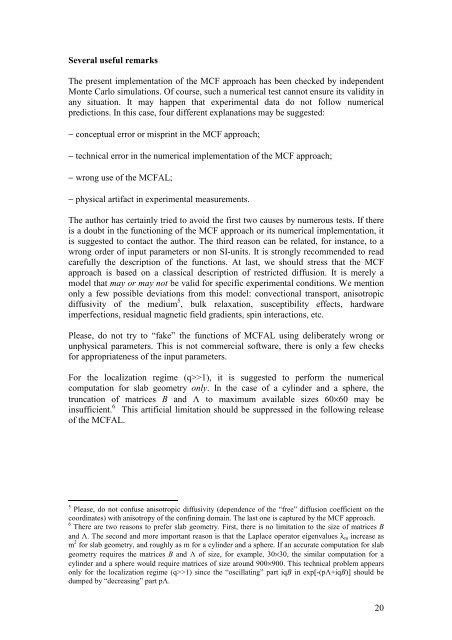Multiple Correlation Function Approach Library
Multiple Correlation Function Approach Library
Multiple Correlation Function Approach Library
You also want an ePaper? Increase the reach of your titles
YUMPU automatically turns print PDFs into web optimized ePapers that Google loves.
Several useful remarksThe present implementation of the MCF approach has been checked by independentMonte Carlo simulations. Of course, such a numerical test cannot ensure its validity inany situation. It may happen that experimental data do not follow numericalpredictions. In this case, four different explanations may be suggested:− conceptual error or misprint in the MCF approach;− technical error in the numerical implementation of the MCF approach;− wrong use of the MCFAL;− physical artifact in experimental measurements.The author has certainly tried to avoid the first two causes by numerous tests. If thereis a doubt in the functioning of the MCF approach or its numerical implementation, itis suggested to contact the author. The third reason can be related, for instance, to awrong order of input parameters or non SI-units. It is strongly recommended to readcarefully the description of the functions. At last, we should stress that the MCFapproach is based on a classical description of restricted diffusion. It is merely amodel that may or may not be valid for specific experimental conditions. We mentiononly a few possible deviations from this model: convectional transport, anisotropicdiffusivity of the medium 5 , bulk relaxation, susceptibility effects, hardwareimperfections, residual magnetic field gradients, spin interactions, etc.Please, do not try to “fake” the functions of MCFAL using deliberately wrong orunphysical parameters. This is not commercial software, there is only a few checksfor appropriateness of the input parameters.For the localization regime (q>>1), it is suggested to perform the numericalcomputation for slab geometry only. In the case of a cylinder and a sphere, thetruncation of matrices B and Λ to maximum available sizes 60×60 may beinsufficient. 6 This artificial limitation should be suppressed in the following releaseof the MCFAL.5 Please, do not confuse anisotropic diffusivity (dependence of the “free” diffusion coefficient on thecoordinates) with anisotropy of the confining domain. The last one is captured by the MCF approach.6 There are two reasons to prefer slab geometry. First, there is no limitation to the size of matrices Band Λ. The second and more important reason is that the Laplace operator eigenvalues λ m increase asm 2 for slab geometry, and roughly as m for a cylinder and a sphere. If an accurate computation for slabgeometry requires the matrices B and Λ of size, for example, 30×30, the similar computation for acylinder and a sphere would require matrices of size around 900×900. This technical problem appearsonly for the localization regime (q>>1) since the “oscillating” part iqB in exp[-(pΛ+iqB)] should bedumped by “decreasing” part pΛ.20










![[Diffusion-Limited Aggregation - A Model for Pattern Formation].](https://img.yumpu.com/52395246/1/190x245/diffusion-limited-aggregation-a-model-for-pattern-formation.jpg?quality=85)





